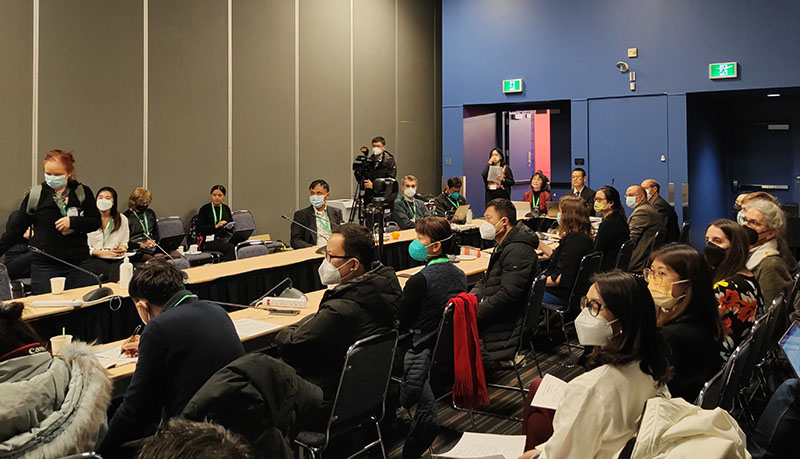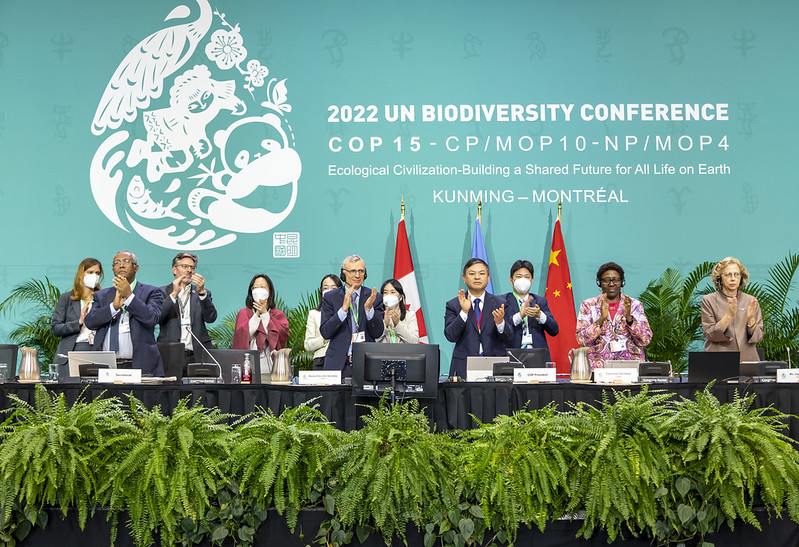In the words of UN Secretary-General António Guterres, the 2022 UN Biodiversity Conference had the “urgent task of making peace with nature.”
The world is losing biodiversity, the variety of all life on earth, at an alarming rate. Ecosystems, from forests and deserts to freshwater and oceans, are in steep decline. One million plant and animal species are threatened with extinction. Genetic diversity is disappearing. The planet’s life-support systems are at stake. Underpinning human wellbeing and livelihoods, biodiversity is the source of essential resources and ecosystem functions that sustain human life, including food production, purification of air and water, and climate stabilization. The 2022 UN Biodiversity Conference aimed to take strong action to reverse this trend. In the words of UN Secretary-General António Guterres, it had the “urgent task of making peace with nature.”
Nations Adopt the “Kunming-Montreal Global Biodiversity Framework” (GBF)
Parties to the Convention on Biological Diversity (CBD) engaged in a lengthy intersessional process amidst a global pandemic, intense negotiations during the meeting, and Presidential and ministerial interventions that pushed for a compromise package on the most controversial—and interlinked—agenda items. In the end, the CBD community delivered. The Kunming-Montreal Global Biodiversity Framework (GBF) will guide biodiversity policy in the years to come, through four overarching goals and a set of targets to be achieved by 2030. Its implementation is to be facilitated by decisions on resource mobilization and on capacity building and technical and scientific cooperation aiming to address the finance and capacity gaps between the developed and the developing world. A monitoring framework, and a decision on mechanisms for planning, monitoring, reporting, and review, are expected to promote and strengthen implementation and compliance. A decision on benefit-sharing from the use of digital sequence information (DSI) on genetic resources aims to ensure that the CBD framework adapts to technological developments and ensures respect for the Convention’s third objective: fair and equitable benefit-sharing.
Ensuring Mountain Biodiversity Protection
Mountains had a spotlight at COP15 during “Ensuring Mountain Biodiversity”, a high-level side event celebrating the International Year of Mountains.
The event highlighted efforts taken to elevate mountain biodiversity and the need for its protection within the Post-2020 outcome and implementation while giving insights into supporting science-policy processes and products. MRI SLC member Shawn Marshall presented “Why Mountains Matter for Biodiversity and People” where he explained how effective science-policy dialogues with local knowledge/experiences can support conservation decisions and management options.
Another high-level side event, "Future Mountains in the Post-2020 Global Biodiversity Framework", focused on the conceptual framework, scientific research, and community actions for sustainable development in the future mountains under the 2020-post global biodiversity framework. The event featured the keynote speech by MRI SLC member Jianchu Xu "From Rio to Kunming, from Kunming to Montreal—The Roads of Mountain Futures". The delegates discussed and unanimously agreed on a Mountain Futures Action Plan (also in Chinese) with a vision, principles, and a set of actions to improve mountain communities’ ecological protection and green development.

Pictured above: Participants at the high-level side event, "Future Mountains in the Post-2020 Global Biodiversity Framework.
Also released during COP15 and in celebration of the International Year of Mountains was a new policy brief, co-authored by MRI SLC member Rob Marchant, which focuses on ecosystem restoration in the mountains. The policy brief highlights the role of healthy mountain ecosystems and their services and provides a set of recommendations to help design effective restoration plans. It also reflects on the achievements made during the last 20 years.
“We are hoping for some progress at COP15, but what is really needed is an international treaty or code of practice that accepts the value of our mountain ecosystems, and I suspect that is some way off,” says Marchant.
Whether the outcomes of COP15 will address such challenges fairly and effectively remains to be seen in less than a decade.
The first part of the UN Biodiversity Conference convened virtually from 11-15 October 2021, with a limited number of delegates physically present in Kunming, China. The meeting’s theme was “Ecological Civilization: Building a Shared Future for All Life on Earth.” It resulted in the adoption of the Kunming Declaration, which called for urgent and integrated action to reflect biodiversity considerations in all sectors of the global economy.
The second part of the UN Biodiversity Conference convened from 7-19 December 2022 in Montreal, Canada, under the presidency of China, and included concurrent meetings of the governing bodies of the Convention and its Protocols: the 15th meeting of the Conference of the Parties to the Convention (COP 15), the tenth meeting of the Conference of the Parties serving as the Meeting of the Parties (MOP 10) to the Cartagena Protocol on Biosafety, and the fourth meeting of the Conference of the Parties serving as the Meeting of the Parties (MOP 4) to the Nagoya Protocol on Access to Genetic Resources and the Fair and Equitable Sharing of Benefits arising from their Utilization. Approximately 16,000 participants attended the session and parallel events, representing governments, UN and international organizations, Indigenous Peoples and local communities (IPLCs), non-governmental organizations, academia, and the private sector.
Further Reading
Summary of the UN Biodiversity Conference: 7-19 December 2022
The first part of this article was first published by the IISD Earth Negotiations Bulletin. You can view the original summary report on the IISD Earth Negotiations Bulletin website.
Cover image by UN Biodiversity







